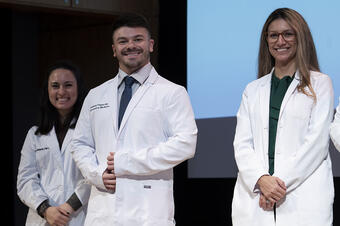By Dave DeFusco
During one of Anthony Pagan’s clinical rounds at St. John’s Episcopal Hospital in his last semester in the Katz School's M.S. in Physician Assistant Studies, he was summoned by the attending physician to perform an ultrasound-guided intravenous procedure on an older man with a life-threatening bowel obstruction.
After an exchange of pleasantries with the patient, Pagan explained the steps that he’d be taking during the procedure but, first, he’d have to palpate an inaccessible vein before inserting a needle, assuring him that it wouldn’t be too painful. The patient nodded and then asked Pagan a question that he gets often given his age: Had he ever performed the procedure?
“I told him that I’d seen quite a few, but I couldn’t lie,” said Pagan. “I told him that it’d be my first one but that we were going to have a doctor present in the room guiding me through the entire procedure to make sure I was doing everything just right. He took that pretty well."
Pagan gathered the necessary equipment, including the ultrasound machine, ultrasound probe, a sterile IV catheter kit and IV tubing. When he identified a suitable vein, he applied a tourniquet and sterilized the area, holding the ultrasound probe in one hand to keep an eye on the vein while using the other hand to insert the IV catheter.
“I was a bundle of excitement and nerves,” said Pagan. “I was, like, ‘Alright, alright, I can do this.’”
He inserted the catheter needle into the vein at a shallow angle while focusing on the needle tip on the snowy ultrasound screen, gently pushing the needle forward but not too quickly so as not to accidentally poke through the other side of the vein. When he correctly positioned the needle, blood started to flow back through the needle and into the IV catheter hub, which is the small plastic tube that goes into the vein to deliver fluids or medication. He moved the catheter further into the vein and removed the needle, connected the IV tubing to the catheter hub and secured it with adhesive tape.
“The ultrasound probe looked like an icicle in the darkness,” said Pagan. “You’re not looking at your hands, you’re looking at the screen while you’re doing it. It’s very intuitive. I was able to learn it kind of easily because it reminded me of a video game.”
Pagan credits the PA program and Professor Abraham Oxilas particularly for instilling “confidence, grit and tenacity” into his approach to patient care. After practicing in other specialties, he prefers emergency medicine because “it’s controlled chaos.”
“You never really know what you’re getting into,” he said. “I enjoy doing things that I can’t easily predict, because you don’t necessarily have to go in with a plan. You just have to assess the situation in the moment and use what you’ve learned and experienced for the benefit of the patient.”
At the end of his clinical rotation, Pagan was asked by the chief attending physician at St. John’s Episcopal Hospital what he wanted to do after graduation. When he said emergency medicine, he was offered a job on the spot. He started in June.

